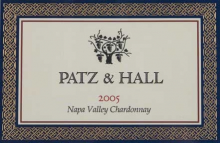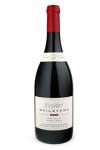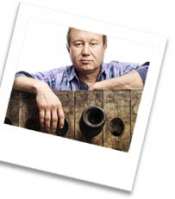The Thanksgiving feast always presents endless possibilities for the wine geek within me. Choosing the wines typically becomes an exploration into the depths of my cellar, often turning up long-forgotten bottles that have gone unnoticed for years, tucked away in some dusty corner of the basement.
I am determined to whittle down the options and keep it simple. For that is what most people do. It is what I did before I had a ‘collection,’ with cases of exotic wines stuffed in every nook and cranny I could find.
 Those were the days! Some of my fondest Thanksgiving memories, actually. A bottle of Chalone Pinot Blanc and a bottle of Chalone Pinot Noir and I was good to go. As far as I could tell, that was the good life. And it wasn’t bad.
Those were the days! Some of my fondest Thanksgiving memories, actually. A bottle of Chalone Pinot Blanc and a bottle of Chalone Pinot Noir and I was good to go. As far as I could tell, that was the good life. And it wasn’t bad.
So today’s advice will be short and sweet. Keep it simple. One white and one red. If you’re ever going to drink one of those rich, mouth-filling California Chardonnays, there is no better setting than Thanksgiving.
The bold aromas and flavors of roasted turkey, savory stuffing and rich sauces and gravies call for wines with good body and strong flavors. Wimpy whites need not apply!
As for a red wine, the conventional wisdom has always held that Beaujolais is the perfect ‘turkey’ wine. It has the fruit to tackle the myriad savory aromas of the Thanksgiving table, but not so muscular and dominating (as a Cabernet Sauvignon might be) that it would overwhelm the delicate flavor of your roasted bird.
I prefer the first cousin of Beaujolais’ Gamay grape, Pinot Noir, which can be found a bit further north in France’s Burgundy region. French Burgundy’s trend on the expensive side, though, and might not be the most cost effective wine selection for a holiday crowd.
Pinot Noir from California, Oregon or New Zealand can be every bit as pleasing as a top-notch red Burgundy, and at a fraction of the cost, although there are some exceptions. I long ago gave up Beaujolais on Thanksgiving in favor of Pinot Noir because of the warmth of Pinot Noir. It’s soft and inviting, with charming aromas and generally more body than even the best Beaujolais.
 Why, you might ask, serve both a white and a red? Because turkey – or roasted chicken or Cornish hen, for that matter – is extremely versatile and nicely complemented by either white or red wine. Not to mention the fact that in any gathering of family and friends you will find red-wine drinkers and white-wine drinkers. The ‘pairing’ is often of minor importance.
Why, you might ask, serve both a white and a red? Because turkey – or roasted chicken or Cornish hen, for that matter – is extremely versatile and nicely complemented by either white or red wine. Not to mention the fact that in any gathering of family and friends you will find red-wine drinkers and white-wine drinkers. The ‘pairing’ is often of minor importance.
A few suggestions:
Chardonnay
Patz & Hall 2004 Chardonnay, Napa Valley ($36) — Seems like Patz & Hall has re-tooled it’s Chardonnay model and has backed away from the fat, overblown Chards for which it used to be famous. This Napa Valley citrusy Chard has richness, but with firm acidity and hints of minerality. 93
Flora Springs 2006 ‘Barrel Fermented’ Chardonnay, Napa Valley ($26) – Vineyard sourcing is important for this wine. Utilizing vineyards from the cool Carneros, the southern end of the Napa Valley, and mid-valley, Flora Springs is able to craft a Chardonnay that has the heft and ripe tropical aromas that say Napa Valley without the heaviness usually associated with those elements. The cooler-climate grapes provide fresh acidity and a citrus/lemon custard aroma that balances the fatness of the pear and peach aromas from warmer areas. 91
Kumeu River 2005 ‘Village’ Chardonnay, New Zealand ($20) – The ’05 Village is beautifully structured, rich and mouth watering, and delivers complex aromas of baked apple, pear and hazelnut. The wine is aged in older oak casks to minimize the influence of the wood tannins and aromas. Beautifully executed and fairly priced. 90
Pinot Noir
Patz & Hall 2005 Chenoweth Ranch Pinot Noir, Russian River Valley ($55) – Seems like winemaker James Hall didn’t get the memo. His Chenoweth Ranch Pinot Noir bucks the trend in California toward heavier, riper Pinot Noir that often tastes more like Syrah than Pinot. The only similarity between the Chenoweth Ranch Pinot and Syrah is the color. This is classic Pinot Noir, with a heady nose that inspires comparisons to Chambertin in all of its floral glory. There are high-toned red fruit aromas such as strawberry and cherry, and on the palate a deep, rich raspberry characteristic unfolds to give the wine another dimension of complexity. The structure and balance are exquisite, even in light of the 14.6 alcohol, and the tannins are fine and mature, allowing for a luxurious, silky mouthfeel and a lingering finish that is sweet and pure. 96
 Baileyana 2005 ‘Grand Firepeak’ Pinot Noir, Edna Valley ($38) – French-born winemaker Christian Roguenant is right at home with the Pinot Noir grape and has reeled off a succession of impressive and ever-improving Pinots since taking the reins at Baileyana more than a decade ago. The Grand Firepeak Cuvee is a Pinot Noir with guts, showing layers of red fruit complexity and good minerality despite ample ripeness. 93
Baileyana 2005 ‘Grand Firepeak’ Pinot Noir, Edna Valley ($38) – French-born winemaker Christian Roguenant is right at home with the Pinot Noir grape and has reeled off a succession of impressive and ever-improving Pinots since taking the reins at Baileyana more than a decade ago. The Grand Firepeak Cuvee is a Pinot Noir with guts, showing layers of red fruit complexity and good minerality despite ample ripeness. 93
Coldstream Hills 2006 Pinot Noir, Australia ($22) – Ever since my first visit to Australia’s Yarra Valley, more than a decade ago, I’ve been convinced this cool region near Melbourne was destined to become another hotspot for top-class Pinot Noir, perhaps on a par with Oregon’s Willamette Valley or California’s Russian River. So far, however, the Yarra has been long on promise but short on delivery. Thus this fairly inexpensive ’06 Pinot from Coldstream Hills is a bit of an eye-opener. It opens in the glass with a gorgeous nose of violets and spice, unfolding on the palate with generous, fleshy layers of red-fruit complexity such as blueberry and cherry, all held together with bright acidity and complemented by backnotes of savory earthiness. The tannins are fine and smooth, contributing to a silky mouthfeel that is worthy of the finest red Burgundy. And at this price, it’s a Pinot lover’s steal! 90
8
